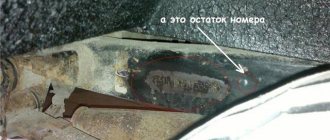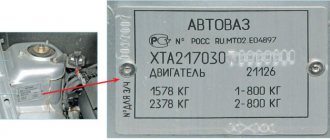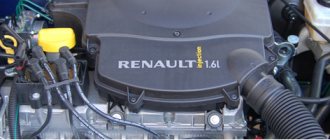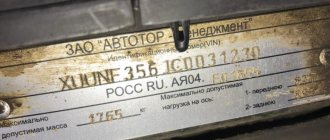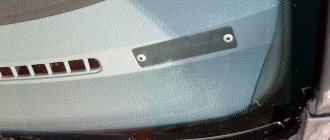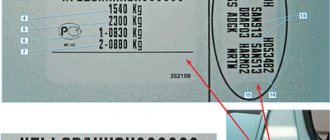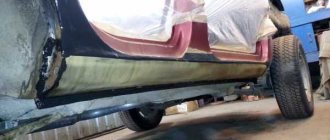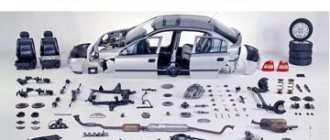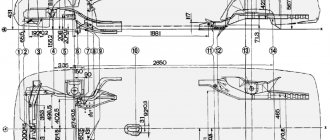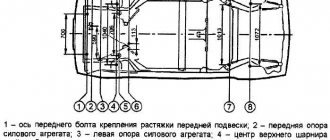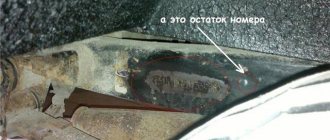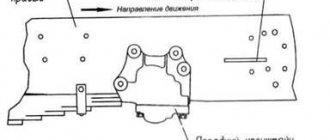All vehicles are equipped with a registration number in order to be identified in certain situations. In any case, this identification system is not effective enough in certain conditions or in the workshop. Manufacturers therefore have a unique code called a frame number that describes and cites very detailed design features of a particular vehicle version.
Thus, the chassis also has its own serial number, or code, to be identified accurately without the possibility of error. Below we will tell you what a chassis number is, what numbers it consists of, and, above all, what it is needed for.
How to find out the frame (chassis) number?
- Since the frame and body have recently “fused” together, they are therefore one whole, and they have the same number for two, so to speak. This applies to all cars, crossovers and other small SUVs. All documents that accompany the car, such as PTS and vehicle registration certificate, must indicate the body number. Therefore, by looking in the corresponding column “Body number” you can find out the chassis number.
- All information from the PTS is duplicated in the vehicle registration certificate. If nothing is indicated in the “Chassis Number” column, look in the “Body Number” column. The chassis number in this case corresponds to the body number.
- Thanks to the vehicle's VIN code, you can find out the chassis number. The VIN code must be written in the documents: in the vehicle registration certificate and in the PTS. You can also find the VIN code on the car itself. There are several places where the car manufacturer can place a small plate with the VIN code on it. The first place where such a sign is placed is the windshield of the car. Looking at it from the outside, standing in front of the driver's seat, you can see the VIN code. The chassis number is the last 6 digits of the VIN code. But this is only if the windshield has not been replaced from the factory! If you did replace the windshield, look under the hood. The rear wall of the engine compartment should tell you these 6 digits of the chassis number. If the engine compartment does not help you, then turn your attention to the thresholds, for example. Or look at the VIN code on the rear beam or in the trunk niche. The manufacturing plant tries to choose a location that is less likely to suffer in an accident or from corrosion.
- The “Owner’s Manual” of the car says exactly where you can find the VIN code on the car body, if suddenly you yourself have not coped with this task.
- On our website you can find a program that, using the VIN code, can “give you” the chassis number. Just go to this program and enter the VIN code in the required window. A minute, and the chassis number is before your eyes.
All about VIN codes
Do you know about your VIN code?
Any car that comes off the assembly line has its own registration data - numbers stamped on the units. You all know that, in principle, any documents can be easily forged. Of course, you can also destroy the numbers. Car registration numbers can be cut off, erased, or new ones knocked out, but, nevertheless, it is their counterfeit ones that dealers in stolen cars most often come across. The good cause of vehicle identification can only be served by numbers applied to those components that legally have identification status. Until recently, the engine, body and chassis were considered as such. Now, as a rule, only the body, in the number of which all information about the car and its individual units is encoded.
Basic provisions of the ISO 3779-1983 Standard
Until the 1980s, almost all cars were identified by a 7-digit chassis number consisting only of numbers. Since the early 80s, automakers, finding such identification not very informative, switched to a 17-digit alphanumeric index.
In 24 countries that are members of the International Organization of ISO Standards, the body of each car produced in them has an individual number. Vehicle Identification Number (VIN), in accordance with the ISO 3779-1983 Standard, is the identification number of each individual vehicle, which encrypts important technical data individually for each vehicle. This is a kind of “Birth Certificate” for each car. The vehicle identification number is almost like a chromosome set. By decrypting it, we can get complete information about the car, which is especially useful when purchasing it. Once again, the VIN consists of 17 alphanumeric characters and contains accurate information about the manufacturer, model, year of manufacture and body number. The symbols are arranged in a certain sequence.
The VIN consists of three independent parts:
1. World Manufacturers Identification (WMI) - global manufacturer index, 2. Vehicle Description Section (VDS) - descriptive part, 3. Vehicle Identification Section (VIS) - distinctive part
WMI
is a code assigned to the manufacturer for the purpose of identifying it. It is assigned by the competent authority of the country where the manufacturer is registered, in accordance with the rules of the international agency acting in the interests of the International Organization for Standardization.
WMI
-The code consists of three characters: the first signifies the country of manufacture, the second signifies the vehicle manufacturer, and the third signifies the manufacturer’s division.
VDS
- this is the second section of the VIN and it consists of six characters that describe the properties of the car. The signs themselves, the sequence of their arrangement and their meaning are determined by the manufacturer. The manufacturer has the right to fill in unused positions with signs chosen at its own discretion.
VIS
is the third section of the VIN consisting of eight characters, and the last four characters of this section must be numbers. If a manufacturer wishes to include a model year or assembly plant designator in the VIS, it is recommended that the model year designator be placed in the first position and the assembly plant designator in the second position.
I note that the ISO 3779-1983 standard is advisory and not mandatory and therefore does not oblige manufacturers to indicate the place of assembly of the car; each company can do this in its own way. Manufacturers are also not required to indicate the year of manufacture and use the recommended signs and positions for them to designate it, so difficulties may arise when determining the year (for example, MV).
Determining the year of manufacture is also complicated by the fact that companies mean by it not a calendar year, but a model year, and begin to punch out the letter or number corresponding to a given year of manufacture already in the second half of the previous year, and sometimes earlier.
Method of applying the identification number.
1. If the vehicle identification number is indicated in any documents, then it must be written on one line and in a continuous line, i.e. without spaces.
2. If the identification number is indicated on the car or on the nameplate, then it must be given either in one line or in two lines and also without spaces; however, the elements of the identification number themselves (for example, WMI, VDS or VIS) should not be separated.
CAR FRAME ZIL
1 Car frame
2 Frame number ZIL-130
3 Vehicle markings
4 Frame repair
5 Repair of towing device
The frame of the ZIL-433360 car is riveted, made of stamped parts, and consists of two spars of variable channel cross-section, connected by cross members. Frame extensions and a buffer are installed in the front part of the frame (Fig. 6-1).
Frame ZIL-130
A towing device with a rubber buffer providing double-sided shock absorption and a hook with a latch for connecting to the trailer's coupling loop is mounted in the hole in the rear cross member of the frame. A towing loop is installed on the chassis of the ZIL-494560 dump truck.
Frame number ZIL-130
Before 1991, the frame number was stamped with paint. After 91, numbers were stamped on the frame with iron padding, at the end of the frame or in front of the cabin, on the right side of the spar. Inspectors are well aware of this; their goal is to recycle all old cars. Now they are not bothering us, but as soon as it comes to registration, problems will immediately arise with registering the car. They know each model, what year and where the frame number is printed; they are taught this. You can do something with the number you painted with paint.
frame paint number
Find the place where it was applied, at least one number. Look what the font was. Type the same font on the computer, cut out a stencil with your number and apply it to the same place using white spray paint. Our task is to make it as close as possible to the factory original and the inspectors will have no questions for you. Over time, the paint will fade and look like the serial number.
ZIL frame number is filled
frame ZIL
Frame: I - for cars with a ZMZ-4063 engine, II - for cars with a GAZ-560 engine
If you do not strengthen your gazelle, then the day is not far off when its frame may burst or break in half; such cases are not uncommon. How to strengthen the frame of a gazelle? It is recommended to strengthen the frame immediately after purchasing a new car, thereby you will save on repairs in the future; you can, of course, not strengthen the frame if you are expected to drive carefully without overloading. We unscrew the bolts at the place where the amplifiers are installed, insert the amplifiers and tighten the bolts back; if you already have a crack in the frame, then you need to drill it out along the edges with a mm drill. Automotive shock absorbers. Fiat spare parts. Spare parts VAZ Lada.
VEHICLE MARKING
in the summary data plate, which is mounted in the cab on the right, on the passenger seat base (Fig. 114). The letters ХТ2 at the beginning of the identification number indicate in encoded form data about the manufacturer: X - geographical area of the country; T - country; 2—manufacturer. The next six digits indicate the car model, followed by the chassis and engine number.
The Latin letter in front of the chassis number indicates the encoded year of manufacture of the vehicle.
In addition, the chassis number is painted on the right side member of the car frame, and the engine number (Fig. 115) is stamped on the upper front part of the engine cylinder block (middle line) on a horizontal area near the eye bolt. The engine model number (top line) and the year of its manufacture (bottom line) are also stamped there.
ZIL car marking
What is VIN and where can I find it?
What is VIN and where can I find it?
Vehicle identification number VIN is a unique vehicle code consisting of 17 characters. The code provides information about the manufacturer and characteristics of the vehicle, and the year of manufacture. The structure of the code is based on the ISO 3779-1983 and ISO 3780 standards. Identification numbers are applied (embossed) on integral components of the body or chassis and on specially made number plates (nameplates):
The identification number ( VIN ) is indicated in Arabic numerals and Latin letters as symbols assigned to the vehicle.
The first part of the VIN, which allows you to identify the vehicle manufacturer, consists of three letters or letters and numbers indicating the geographical area, the country code and the vehicle manufacturer code, assigned in the prescribed manner.
The second part of the VIN is the descriptive part of the identification number and consists of six characters that identify the vehicle according to the design documentation.
Frame repair
When repairing frames, it is necessary to check the tightness of the rivet joints, the presence of cracks in the flanges of the side members and cross members, as well as possible deflection and skew of the side members. Below are recommendations for correcting faults found on frames.
Rivet joints are checked by tapping with a hammer. Loose (rattling) rivets should be replaced. Tightening loose rivets has no effect. Worn holes should be drilled to accommodate the increased diameter of the rivet. If the holes for the rivets are heavily worn (more than 15% of the nominal diameter), the holes can be welded and re-drilled, and then strengthened by running a conical punch through them.
The rivets must fit tightly into their holes. If there is a displacement of the mating parts or if the diameter of the holes in them is different, the holes should be drilled or reamed. The mating parts of the frame must be pressed tightly against each other, since the presence of a gap will allow the body of the rivet being pressed to fill this gap, forming a so-called “blind” washer. If there are difficulties, you should eliminate the gap, using the hole located nearby, tighten the mating parts with a bolt and nut or clamps, and only then carry out riveting.
Frame drawing
ZIL-130 frame drawing
In garage conditions, it is recommended to use hot riveting, that is, heating the rivets in electric or other heating ovens. After cooling, a hot rivet will tighten the mating parts even more tightly. At auto repair plants, preference should be given to hydroriveting using cold rivets. In order not to violate the established position of the parts, replacement of rivets should be done sequentially, that is, first cut off one rivet, install a new one in its place, then cut off the next one, etc.
After riveting, the rivet heads must be correctly positioned (along the axis of the rivet), fully compressed and must have a geometrically correct shape without distortions, sagging or cracks. The diameter of the newly formed rivet head must be at least 1.5 times the diameter of the rod. Riveted joints must ensure a tight fit of the surfaces of the parts being connected over a diameter equal to two diameters of the rivet rod. It is possible to replace the cut rivet with a bolt with a spring washer and a nut.
Deflections and distortions. Determined by inspection, as well as checking using rulers and templates. The curvature of the side members in the plane of the vertical wall should not exceed 2 mm over a wild 1000 mm or 5 mm over the entire length of the spar. Bent frame parts are straightened in a cold state.
Mutual displacement of the frame side members, causing non-perpendicularity of the cross members with respect to the side members, is not allowed. The longitudinal displacement of the side members can be checked by measuring the distance between two cross-lying holes for the engine mounting bolts. A skewed frame should be re-riveted and bent parts replaced.
ZIL-130 frame dimensions
ZIL-130 frame dimensions
Cracks. If cracks are found on the shock absorber spring mounting brackets. These parts should be replaced. If there are cracks on the frame side members, it is necessary to determine the boundaries of the cracks. To do this, it is recommended to thoroughly clean the crack to a metallic shine, rinse with kerosene, wipe dry and tap with a hammer. If there is a crack, kerosene will come out.
At the end of the crack or 5...8 mm away from it, you should mark it with a core and drill a through hole with a diameter of 5 mm along the core. Use a chisel or an emery wheel to divide the groove at an angle of 90° along the crack for welding to a depth of 3 mm on both sides. Fill the crack on both sides, starting from the drilled hole and ending at the end of the crack. Cutting for welding can be replaced by sawing the defective frame part with a hacksaw along the crack to its entire length.
When repairing frame parts, manual electric arc welding with high-quality electrodes or semi-automatic welding in a protective environment should be used. Welding work must be carried out by a highly qualified welder. To weld cracks in frame parts, according to NIIAT, it is recommended to use OZS-b, VN-48 and UONI 13/55 electrodes.
The weld deposit should not rise above the surface of the part by more than 2 mm. In the welding zone, as a result of thermal influence, the fatigue strength of the metal decreases. Strengthening this zone can be done by peening using a pneumatic or plumbing hammer. Any cracks in the side members and cross members can be repaired by welding and installing reinforcing linings (Fig. 6-2).
Types of reinforcement pads
The overlay must be tightly fitted to the configuration of the part being reinforced and connected to the part with rivets or bolts. Welding of reinforcing linings in all cases should be done only with longitudinal seams. When installing reinforcing linings, you should not create excessive rigidity of the assembly at the site of cracks, as this causes the appearance of new cracks at the ends of the reinforcing linings. The material of the reinforcing linings can be steel 3, steel 0.8 or steel 20 with a thickness of 5 mm.
If cracks appear on the lower flange of the frame side members in the area where the cross member is connected to the side member, it is necessary to carry out the following operations to restore the frame: make a reinforcing lining 3
Spar reinforcement
Spar reinforcement:
1 — crack of the frame spar; 2 - drilled hole
end of the crack; 3 — overlay; 4 - bolt; 5 - rivet
weld the cracks on the spar and on the cross member, having previously cut the edges for welding and drilling the end of the cracks, cut off the rivets securing the cross member on the lower flange of the side members;
rivet the cross member and reinforcing lining to the lower flange of the side members. If it is impossible to use rivets 5, install bolts 4 and fix the holes for the bolts using a reamer. In case of significant damage to the holes, install bolts with an increased diameter of up to 14 mm;
Weld the reinforcing lining to the lower flange of the spar and to the cross member using only longitudinal seams. The seams should not be extended to the ends of the reinforcing lining by approximately 20...30 mm.
Check the quality of welds by external inspection. Cracks in other places of the frame are repaired in a similar way.
frame size ZIL-433362 frame size ZIL-130
Towbar repair
The design of the towing device is shown in Fig. 6-4. When disassembling a towbar with a rubber buffer, the following operations must be performed.
Unscrew the cap securing bolt and remove it. Unscrew the nut by removing cotter pin 11. Unscrew nut 17 securing the hook rod and remove the hook assembly.
Unscrew the nuts 10 securing the cover 4 and the housing 1 to the frame cross member, remove the housing 1 and remove from it the rubber buffer 2 and support washers 3. Fig. 6-3) of the spar; To disconnect the latch 5 from the towing hook, you need to remove the cotter pin, unscrew the nut 7 and knock out the axle 12.
To remove pawl 6 from the latch, you need to unscrew the locking bolt and knock out axle 8. Assembling the towbar with the rubber element is done in the reverse order. The parameters of the towing device parts are given in Table 6-2.
Towbar Table 6-2 Table 6-2
Frame weight is approximately 400 kilograms
PHOTO FRAMES
Frame ZIL-130
WATCH THE VIDEO
Where is the chassis number for the ZIL 130
Here I will try to answer your questions about the registration of this miracle of technology))
I will write what I know, advice and additions are welcome. I hope this information will be useful for someone and will save you from mistakes.
Briefly how the process works.
I go to the local traffic police, write a statement with a request to give me a referral to NAMI (or any other certification body)
I’m going to a licensed car service center, taking documents about the work done on the car.
I come to NAMI (I contact via the Internet if I live far away), provide documentation, conduct negotiations, provide a certificate-invoice for the purchase of a ZIL130 cab, documents for a Ford, necessary photographs, diagrams, etc. - depending on the type of alterations and the requirements of the certification department employees.
If everything is successful, I pay the bill for certification services and receive a positive conclusion.
I take the NAMI conclusion, certificates from the car service center that “carried out” the work, documents for the car and go back to the traffic police
Based on the positive conclusion of NAMI, the traffic police makes changes to the registration documents, I undergo technical inspection and from that moment the car is considered legalized and suitable for use.
2. My main mistake.
Everything would be just wonderful... The Ford, which I own, is a frame car, the ZIL 130 cab is placed on the frame... What could be easier than just registering it. replacement of the body, and not a load-bearing one!
But, out of my stupidity, I did not register the car, because... I was sure that it would be better to install it later, after certification. But I did not take into account the fact that we live in an extremely strange state and, it turns out, FOR SUCCESSFUL REGISTRATION OF ALTERATIONS AND CERTIFICATION OF CHANGES IN THE VEHICLE DESIGN, THE CAR MUST BE REGISTERED.
My Ford is in transit, and according to our legislation is not a vehicle. Accordingly, I cannot go to the traffic police and take a referral to NAMI, because... I’m not registered with this very traffic police...
3. It would seem that it could be simpler - register Ford and that’s it.
Because The Ford body was badly damaged after the accident, I cut it into pieces and threw it into scrap metal. I left only a piece of the body with the VIN, the only numbered part of my Ford. Yes, yes, my donor is an American car, which means: the frame is used, the engine is used. The only numbered part is the ill-fated body...
Having come with a piece of iron and good intentions to our traffic police, I was ridiculed and realized that I was in trouble - I won’t register the car ((
4. There is always a way out.
So, what should I do... In this situation, I have two options.
A. A miracle will happen and I will be able to register Ford on the basis of my existing title, purchase and sale agreement, transits and a piece of body with wine.
B. I will have to buy (the cheaper the better) a dead, but complete with serialized parts ZIL 130, register it in my name and, based on its documents, make changes to the design.
Brief history of the model
Gazelle belongs to a series of Russian light-duty vehicles. The model range of the series begins its history in the summer of 1994, or more precisely, in July. The main production is concentrated at the Gorky Automobile Plant, but there are several more factories located on the territory of the former Soviet republics and abroad. They assemble cars from finished parts.
Classic Gazelle truck with kung
After 2003, a representative of the second generation came off the assembly line. Its differences from the first can be listed on the fingers of one hand. A new bumper, lighting fixtures and radiator grille were installed. Everything else is unchanged. Two and a half years later, the millionth Gazelle was released, which confirms the popularity of the model.
The second series was the leader on the Russian market until February 2010. It was at this time that the production of the Gazelle-Business model began. And 3 years later, in March 2013, the first Gazelle-Next rolled off the assembly line. From the old car she inherited only the gearbox, rear axle and frame; all other elements were updated.
In the autumn of the same year, the automaker presented the beginning of a new series “Gazelle - Business CNG”. This happened at the international exhibition GasSUF.
Towards the end of the year, the English agency INTERBRAND named the Nizhny Novgorod Automobile Plant the most influential Russian brand. Although in 2009 he took only 29th place.
How to find out the chassis number by VIN?
First, let's figure out where the chassis came from for cars, this is not an airplane. The word “chassis” in the automotive environment comes from the English “chassis”, which means some significant, essential part of the car; the word “frame” comes closest in meaning.
Once upon a time, the main structural part of a car was the frame on which the engine was mounted, wheels, gearbox, transmission, and other parts that set the car in motion were attached. Next, the body was installed on top of the frame, although it was possible to drive without it. The body and frame could be assembled in parallel and combined with each other as desired, therefore, to identify a car consisting of a body and frame, two additional numbers were used (in addition to the VIN): the frame number (also known as the chassis number) and the body number.
With the development of science and technology, the bulky frame began to be abandoned in favor of a durable body, and cars began to be assembled not around the frame, but using a different technology. First, the car body was made, which was the load-bearing element of the structure, and then the engine was installed in it, wheels, transmission and everything else were attached to it. The car became a monolith and its frame (chassis) number was no longer due to the lack of one. In addition, in order not to bother, the manufacturers decided that the body number will coincide with the VIN. Therefore, vehicles with a monocoque body do not have a chassis number.
Currently, frame cars are still being produced. As a rule, these are trucks and serious SUVs like Mercedes Gelandewagen, Hummer H1, Jeep Wrangler and others. You can find out more about them by using a search, for example, using the phrase “frame SUVs.” Such a car has a chassis number and matches the VIN, but most often the body number will be missing.
So, passenger cars with a monocoque body do not have a chassis number; for SUVs with a frame structure, the chassis number coincides with the VIN code.
What will you learn by checking the car's chassis?
By checking a car using any license plate, you can find out the following information:
- History of registration actions;
- Participation in an accident;
- Number in hijacking;
- Availability of restrictions;
- Information from insurance companies;
- Information from the diagnostic card;
- Data from customs authorities;
- Real mileage;
- Information about previous owners;
- Operation as a taxi and more.
AutoHistory provides data on all cars that are registered in the Russian Federation.
